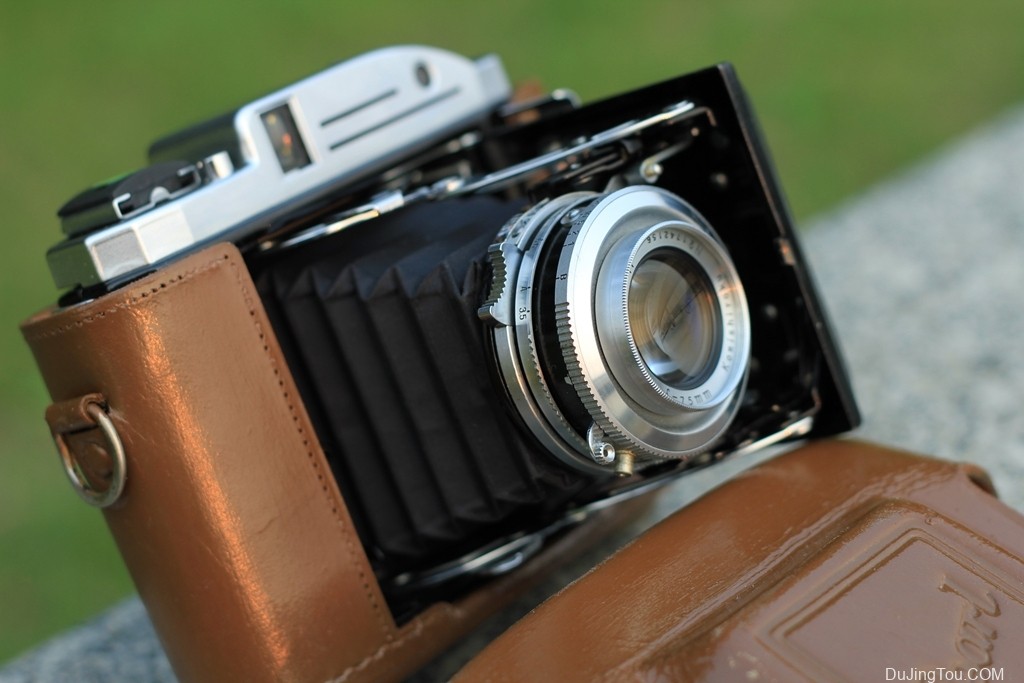
总理机是什么,柯尼卡 珍珠III 周总理喜欢的相机KONICA 柯尼卡 Pearl III,网上流传一张周总理手持相机的照片,相机的型号就是 柯尼卡 Pearl III
Pearl III代,1952年小西六中画幅(6X4.5)经典名机,外形非常小巧便携,手掌大小,轻松装入口袋,工艺精湛,联动测距黄斑对焦,Hexar 75mm f/3.5成像惊艳,锐利无比,不可多得利器。产量较小,市场难觅踪影,号称”日本的军旗ROSS ENSIGN AUTORANGE 16-20″
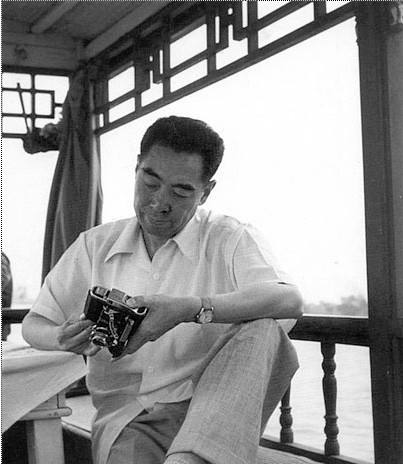
英文资料
All these Pearl models share a design quirk that is likely to confuse somebody who is moderately accustomed to other folders but is new to any in this particular line. What are obviously the shutter-release button at the top of the body and the door-opening button at the top of the door are in fact the reverse of what they seem: the photographer opens the door with the button on the top plate or top housing, and releases the shutter with the button on the opened door.
Pearl and Pearl RS, with uncoupled rangefinder 
The Pearl (in retrospect Pearl I, first half of 1949[1]) has the same basic body as the Semi Pearl, with a top housing (simply inscribed “Pearl”) for a viewfinder and an uncoupled rangefinder. The rangefinder is set by a knob above the top housing, and the distance read must be transfered by the user to the distance scale of the lens. Film advance is still by key. The back has only one red window and is similar to the last examples of the Semi Pearl. The camera retains the combination of a coated Hexar75mm f/4.5 lens and a Durax shutter (1–100, B, T) found on the Semi Pearl. There is still no flash synchronization.[2] Presumably “Semi” was dropped from the name in view of the unlikeliness of a revival of any 6×9 folder (the prewar 6×9 Pearl had been rather unusual among Japanese cameras even when new, and even a modernized successor would probably have struck most photographers in 1949 as a bulky extravagance); the disappearance of the Baby Pearl may have been another factor.
The Pearl RS (in retrospect Pearl I RS, but also simply inscribed “Pearl”; late 1950[3]) has a Konirapid-S shutter (B, 1–500) with Kodak-type flash synchronization. An accessory shoe is added at the top right of the camera (as seen by a photographer holding it horizontally), the back latch is modified and the strap has disappeared.[4] The price in 1951 was ¥14,850.[5]
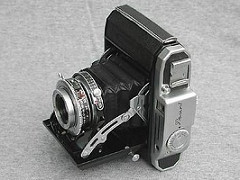 |
 |
 |
 |
 |
 |
 |
 |
 |
|
| Pearl RS. Pictures courtesy of Thomas Harvey. (Image rights) | ||||
Pearl II and IIB, with coupled rangefinder 
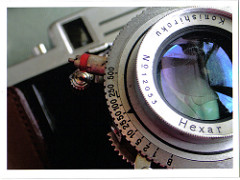 |
| Pearl II. Picture by Bye Bye Bird. (Image rights) |
The Pearl II was released together with the Pearl RS and maybe sold a little after;[6] it is the same camera with a coupled rangefinder and inscribed Pearl II on the top housing. The focusing tab is modified and the focusing scale has disappeared from the front assembly. It is replaced by a rotating disc that shows the distance against a simple depth-of-field scale, placed under a window in the top housing, where the uncoupled model has a focusing knob for the rangefinder. In 1952[7] an f/3.5 Hexar option (¥30,150) was added to the standard f/4.5 Hexar (¥26,650). With the f/4.5 lens, the camera’s dimensions open are 120×100×92mm (43mm closed); it weighs 580g.[8]
In response to increasing competition from 35mm cameras, the Pearl IIB (still engraved Pearl II) was released in mid-1955[9] as a cheaper (¥23,500) alternative to the II (¥30,150). It retains the f/3.5 Hexar lens but the shutter is a Durax-S (top speed 1/400) and the focusing scale is back to the front assembly. There is still a depth-of-field scale above the top housing, but it must be turned manually. The Pearl IIB has one innovation: a PC rather than Kodak flash terminal.[10] (At least one example of the Pearl II has been observed with this feature.)
Pearl III, with auto-stop advance 
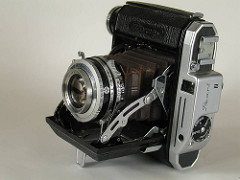 |
| Pearl III L. Picture by Mech_for_i. (Image rights) |
The Pearl III (late 1955[11], inscribed Pearl III above the top housing) adds “semi-automatic” (auto-stop) film advance: once the “start” line on the backup paper is lined up with a dot on the film rail, the camera calculates how far the photographer may wind the film before each exposure. The red window accordingly disappears from the film back. An advance knob replaces the advance key of the previous models, it contains a manually reset exposure counter. The auto-stop mechanism was designed by Nakagawa Kenzō and supplied to Konishiroku by his company Aram Kōgaku, at a pace of 2,000 units per month.[12]
The Pearl III also substitutes a film-reminder dial (color, panchromatic, etc., as well as speed) for the distance and depth-of-field dial of the II. It retains the Konirapid S shutter of the II but has the PC flash terminal of the IIB. The lens is the Hexar f/3.5, except for a few examples said to be fitted with a three-element Konitor lens, certainly the same 75mm f/3.5 as on the Aram Six. The focusing ring is fitted with a concave tab and a depth-of-field scale.[13]
There are two later variants, which are also simply inscribed Pearl III and must be distinguished by looking at the lens. The Pearl IIIMX (1956[14]) replaces the Konirapid S with a Seikosha-MX shutter. This adds X synchronization for electronic flash, becoming popular at around this time. In a time of increased competition in the industry, companies such as Konishiroku that had previously produced shutters for their own cameras found it more economical to buy them in from either Seikosha or Copal.[15] The Hexar lens on this model has a seven-digit serial number and is said to be an improved model (maybe recomputed).[16] The Pearl IIIL (1957[17]) has two further innovations: a Seikosha-MXL shutter, using the light-value system, and a new amber coating for the lens.[18] When closed, the IIIL has the same dimensions as the II, and weighs 600g.[19]
The Pearl III was succeeded in December 1958 by the Pearl IV, which is a radical redesign of the original concept.




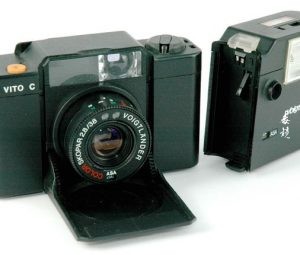

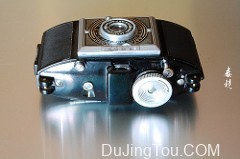
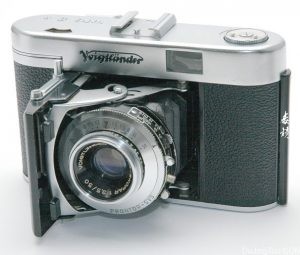
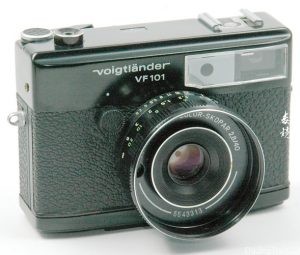
请问,这部相机的镜头是3组5片吗?对比 超级依康塔531/16的镜头,怎样的情况?或者超级依康塔531/16的镜头是怎样的结构?谢谢!
531系列不是我的菜,到目前为止我还一部都没玩,不过 珍珠系列的镜头都还是很感人的。出片很好。缺点是操作有点反人类,对焦也很别扭!
总理在用两指拧动拨片旋钮,看红窗过卷,从哪里看出是珍珠三?
恩后来 争论了很久 很多人都说是珍珠二。